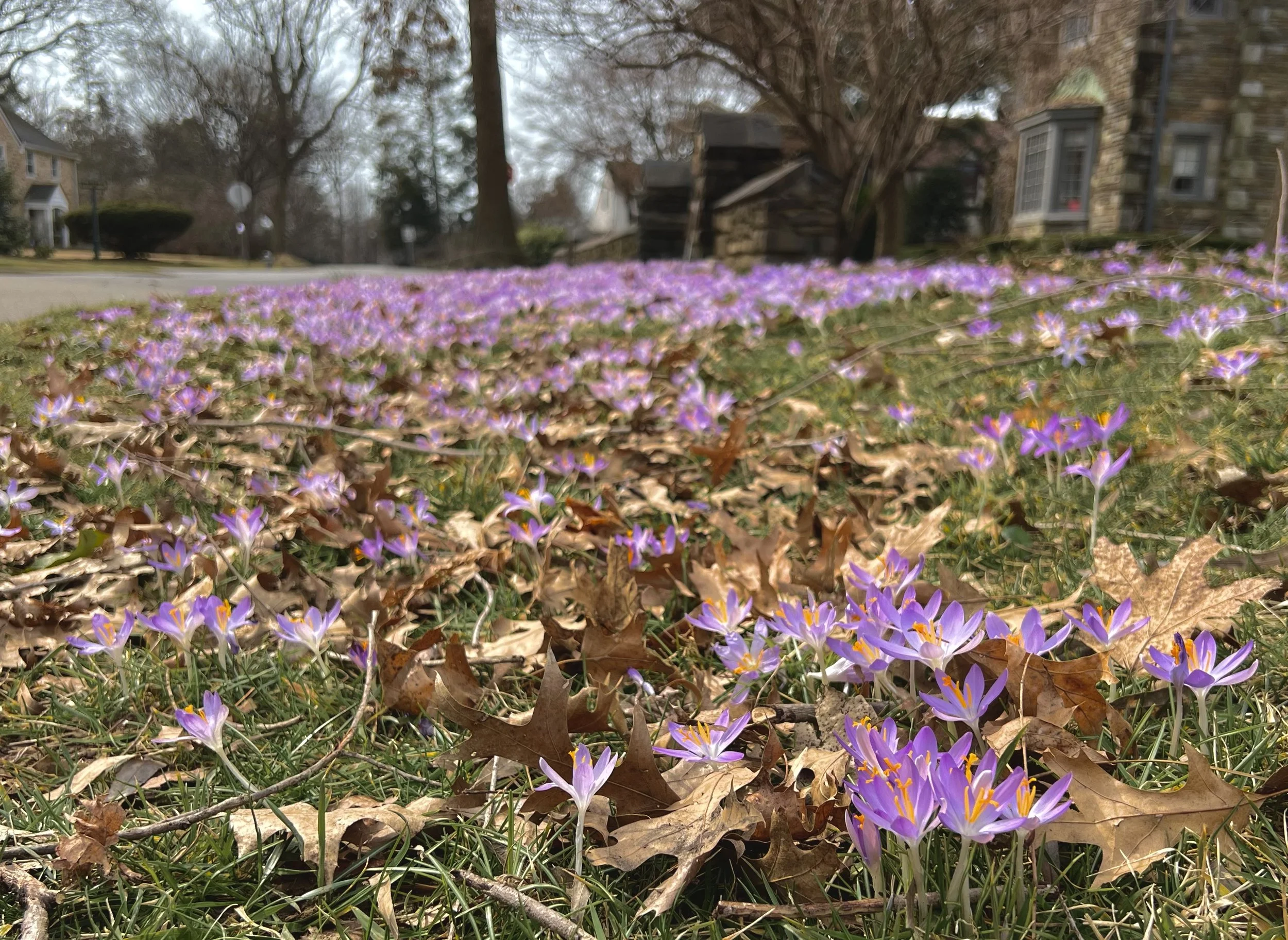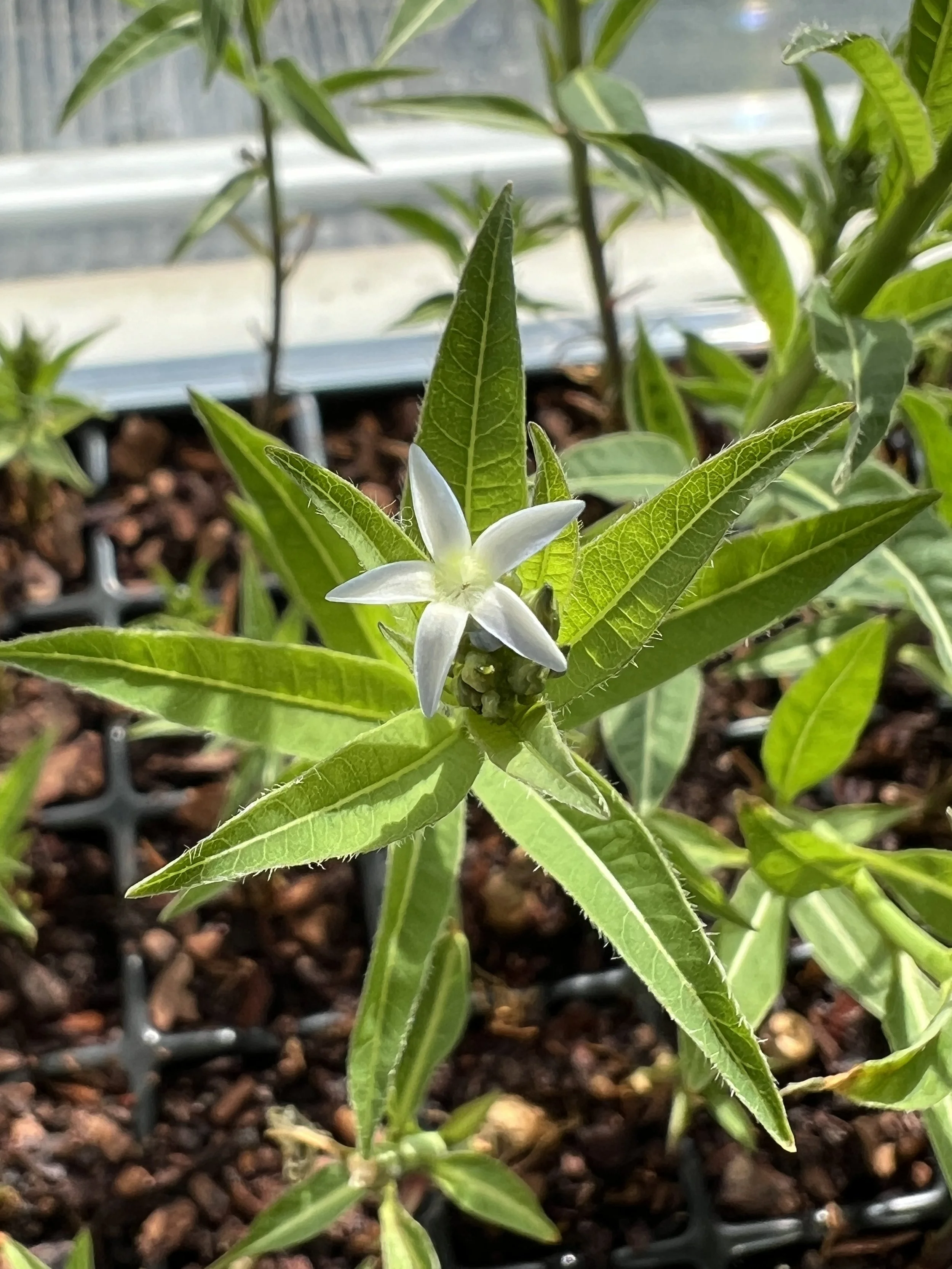thoughts from the studio and field
The following posts reflect our process, inspiration, and lessons learned as we design and install landscapes and watch them develop each season.
Crocuses in Bloom
A beautiful shimmer of purple covering this Bala Cynwyd lawn.
Crocuses blooming in this Bala Cynwyd lawn are absolutely eye-catching.
I never really noticed this lawn or landscape before. It was mostly just a house on a street that I would pass by on my day-to-day driving. These crocuses literally stopped me in my tracks. The time between seeing them from my truck, pulling over, parking, and getting out to take some photos was less than a minute.
That seems reflective of what crocuses do in the landscape. They catch your eye quickly. They bloom in a beautiful flash, or in spurts based on the weather. Some years they feel perfectly aligned with gorgeous spring weather; other years they are fighting it out with snow.
As a designer focusing on low-maintenance landscapes and native plants, these crocuses brought up some new ideas for me.
What role could smaller, early-season bulbs play in the landscape?
Could they be used to add a new dynamic to lawn areas in spring, framing pathways or views of the home?
How could they blur the lines between lawn and planted areas?
Whatever the shifting weather offers each spring, crocuses provide the potential for a beautiful flash of color weeks before hyacinths, daffodils and tulips emerge.
They are beautiful and worth considering in landscape designs.
Roots to Flowers in 6 weeks
Amsonia are some of my favorite native perennials. Amsonia hubrechtii is the most commonly seen species along the Main Line and it is primarily grown for its fine leaves that take on a shaggy yellow appearance at the end of the season and look awesome paired with grasses.
‘Grande’ is an incredible selection of another species called Amsonia tabernamontani. It has broad leaves and beautiful clusters of blue flowers from late April through May. The foliage adds an elegant green texture to the landscape once flowers have faded.
Grande isn’t the easiest selection to find, so I gathered 2 clumps from a generous client in Villanova in December and now have 40 plugs and dozens of larger plants ready for potting and planting this spring.
Working with the plants used in landscape designs from roots to flowers keeps you connected to how the plants develop over time and function in the field.
There are beautiful varieties of native plants that have been carefully tested and selected and can be used in a garden setting to support wildlife and provide a beautiful aesthetic without looking out of control. Many, like this Amsonia have drought and deer resistant qualities that are hard to beat in addition to the gorgeous flowers.
Looking forward to bringing these perennials back out into the landscape as part of several new designs in just a few weeks.
Amsonia are some of my favorite native perennials.
Amsonia hubrechtii is the most commonly seen species along the Main Line. It is primarily grown for its fine leaves that take on a yellow shaggy appearance at the end of the season and look awesome paired with grasses.
‘Grande’ is an incredible selection of another species called Amsonia tabernamontani. It has broad leaves and beautiful clusters of blue flowers from late April through May. The foliage adds an elegant green texture to the landscape once flowers have faded.
’Grande’ isn’t the easiest selection to find, so I gathered 2 clumps from a generous client in Villanova in December and now have 40 plugs and dozens of larger plants ready for potting and planting this spring.
Working with the plants used in landscape designs from roots to flowers keeps you connected and growing in your understanding of how the plants develop over time and function in the field.
There are beautiful varieties of native plants that have been carefully tested and selected and can be used in a garden setting to support wildlife and provide a beautiful aesthetic without looking out of control. Many, like this Amsonia have drought and deer resistant qualities that are hard to beat in addition to the gorgeous flowers. The beautiful flowers, lush foliage and deer-resistance make them a versatile perennial that fits in to a city garden in Philadelphia, a formal on the Main Line, a naturalistic Chester County planting, or a coastal garden at the shore.
We are looking forward to bringing these perennials out into the landscape with several new designs in just a few weeks.
Designing with Evergreens
Evergreens play an important role in the designed landscape. They provide year-round screening and privacy and also structure the landscape in winter. Beyond just being functional, species like Southern Magnolia have beautiful fragrant spring flowers. Available in a variety of selections from full-sized to dwarf species, Southern Magnolias are a great evergreen tree to consider planting.
Evergreens play an important role in the designed landscape.
They provide year-round screening and privacy and also maintain the structure of the landscape design in winter. Species like Southern Magnolia expand the framework for evergreens with their beautiful white flowers that have a lemon-soapy fragrance as they bloom in late spring.
There are varieties of Southern Magnolias ranging from full-sized trees that are 40-60 feet tall down to dwarf species in the 16-20 foot tall range.
One of the beautiful elements of all Southern Magnolias is their thick glossy foliage which have velvety brown undersides. The leaves are attractive year round and have a beautiful depth to them, making them stand out as individual plants and when grouped together.
They do well when planted in spring and get an entire growing season to establish before winter and you get to enjoy the flowers. If you have a spot in your landscape that could use some evergreen screens that can also serve as a focal point, consider in a Southern Magnolia might be a good addition this season.
Meadows in winter
Meadows in Winter
How do you design a meadow with native grasses and perennial wildflowers and establish it successfully? Wont it look tall or wild? How often will I have to reseed it? If I just stop mowing the lawn, wont it turn into a beautiful meadow? Can I just sprinkle some seeds over my existing lawn?
There are a lot of questions when it comes to meadows.
Transitioning a portion of your property into a meadow takes understanding, planning and management. Understanding your site now and as it was used in the past will give you a foundation for the conditions that exist like sun and shade, moisture, and weed pressure. Planning your landscape with species that match the different conditions sets up a meadow that will successfully establish and thrive in your unique space. Installing and managing the meadow over the first few seasons enables you to control problems as the arise and before they grow larger.
At a site visit in Glen Mills PA yesterday, I was consulting the homeowner on the state of his existing meadow installed by a contractor several seasons ago. We discussed the challenges that were present with weed pressure, and the difference between what he expected and how the meadow actually looked after several seasons.
There was a good covering of Little Bluestem, which is an excellent warm-season, native grass that comes back each year. It grows 2-3 feet tall and looks awesome during the growing season and after it has dried out and stays standing in winter. Little Bluestem provide stems for insects to place eggs, seeds for birds to eat, and cover for smaller animals to inhabit.
One of the disappointments for the homeowner was the lack of flowering perennials. When the meadow was seeded several years ago in summer it was followed by several weeks of drought conditions. Adding sprinkler and timed irrigation had enabled many of the seeded species to germinate on the bare soil, but also did the same for the weed species. During the following seasons, weeds were managed by hand removal and areas that had become badly disturbed were reseeded. The homeowner mentioned that he had seen a handful of flowering perennials over the course of 3 years, but it was not what he envisioned. he anticipated the meadow being filled with bright flowers throughout much of the year, matching the picture from the seed mix.
Several weeks ago, the meadow was cut, aerated and seeded again.
The disturbance of weeding and exposing soil created a cycle of bringing buried seeds up to the surface, both desirable native species and undesirable weed species, exposing both to sunlight and encouraging germination. We discussed needing to change the cycle to allow the seeded meadow plants to establish, while controlling the weeds without creating more disruption. Unlike a vegetable garden with soil that is tilled and annual plants that are grown and then cleared every year, a meadow needs to establish over seasons, promoting the beneficial native plants, while being managed to control and outcompete the undesirable weed species.
We developed a plan for several site visits this spring and summer to implement targeted weed control and monitoring to encourage the native meadow species. As we examined the meadow up close, we noticed some tiny Black eyed Susan (Rudbeckia hirta), Lanceleaf Coreopsis (Coreopsis lanceolata) and Eastern Beardtongue (Penstemon digitalis) seedlings scattered throughout. They looked like they had been waiting for their turn to emerge with the rest of the meadow, establish flowers, and set seed.
The plan for this season is to manage and encourage this designed meadow to work beautifully as it springs into new growth, blooms in summer and fall, and maintains its aesthetic as an attractive designed meadow in winter.
Why design a landscape?
When does it make sense to step back and plan your landscape as a complement to the rest of your home?
Designing a landscape can be intimidating.
Typically when a house is purchased there is “a bit” of renovation work to bring it from its previous use and condition to the home you are envisioning. Functional elements like the roof, windows, kitchens and bathrooms need to work and also provide beautiful spaces for the tasks of everyday living. By the time repairs and renovations are complete, It can take a few years to have the energy to begin imagining what the landscape could be.
While it can be overwhelming approach a new project thinking through the variables and details of the landscape, working with a designer to develop a plan can help put things into perspective. Starting with a zoomed out approach and developing a concept for the way your entire property functions, you can build the design in phases so that it matches your dream outdoor space and the way you use your home everyday.
Beginning with questions about how guests arrive and move around your property, which views are most important to preserve, any areas are important to screen and seasons of heightened use and activity for the landscape all contribute to a thorough plan for what your landscape can become. With a plan in place, installation can be budgeted and phased to begin developing your dream landscape.
Sometimes the busyness of getting out the door and from one activity to another can create weeks and seasons and years where the landscape goes by without being noticed. Hiring a designer can be one approach to developing the outdoor spaces of your home so they can be enjoyed in any capacity, in spring, summer, fall and winter.






